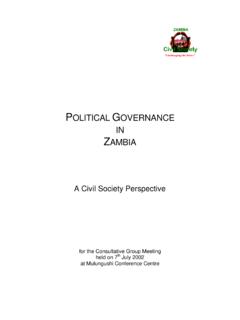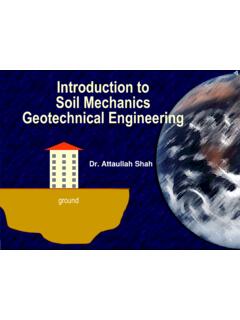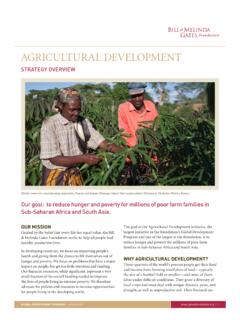Transcription of 2. AGRICULTURE IN MALAWI - SARPN
1 Dept. of International Environment and Development Studies, Noragric 2. AGRICULTURE IN MALAWI . PRESENT CHARACTERISTICS. AGRICULTURE is the major economic activity in MALAWI , accounting for about 40 % of the gross domestic product (GDP) and employing more than 80 % of the economically active rural popu- lation (GoM, 2004). Furthermore, AGRICULTURE is the major source of foreign exchange earnings, amounting to about 89 % of the total. Tobacco accounts for around 60 %, with tea and sugar con- tributing about 10 % each. The agricultural sector has a major impact on the rest of the econ- omy. AGRICULTURE relies mainly on rain-fed crop production; formally or semi-formally irrigated land is only 28,000 hectares. Livestock contributes about 7 % of GDP. Cattle, goats, sheep, pigs and chickens are the major livestock providing for both subsistence and commercial require- ments. Production and consumption of animal products are very low.
2 Exports of animals and animal products are virtually non-existent (Campher et al., 2003). About half the dairy products consumed in MALAWI are imported. As cropping extends further into grazing areas, the numbers of ruminant livestock, especially cattle, continue to decrease. MALAWI has one of the highest population densities in sub-Saharan Africa with an area of arable land per capita of hectare, compared to in Zambia and in sub-Saharan Africa as a whole (World Bank, 2003). Other countries on the continent with similar population densities have two rainy seasons (which help spread harvests over the year and thus reduce the effect of the hungry season') rather than the single rainy season of MALAWI (which, except where irriga- tion is used, means only one major harvest is possible each year). Maize is the staple food and the dominant crop. It occupies 60 % of cultivated land (GoM, 2003). Most of the maize is grown by smallholders and consists of low-yielding local (unimproved) va- rieties1.
3 Maize is produced using human labour with hand-held hoes, and in loose rotations with groundnut and sunflower. Increasingly, maize is grown on the same land year after year, often sparsely intercropped with bean, groundnut, cowpea or pumpkin. Other important smallholder crops produced include rice, groundnut, soyabean and root crops. Most of these are for local con- sumption, although there is some trade in rice and groundnut. In the Southern Region, where the average population density reaches 215 persons per square kilometre, maize is the main crop in nearly 90 % of the area and contributes 80 % of daily food calories. Some 60 % of rural house- holds (and 41 % of the total population) produce less than they need to feed themselves through the year. Carr (1994) attributes the popularity of maize to its efficiency as a per hectare calorie pro- ducer compared to the other available food plants. As land availability declines, the efficiency of calorie production per hectare becomes of greater importance to farmers.
4 Thus the food security of resource-poor households is critically dependent on the productivity and sustainability of maize-based cropping systems. However, are soil fertility declines, maize tend to be replaced by cassava. Structure of the agricultural sector Agricultural land in MALAWI is divided between the customary (smallholder) sector, which occu- pies million hectare, and the estate (large scale) sector ( million hectare of private land 1. For very good reasons: results from an extensive programme of on-farm demonstrations conducted over four sea- sons in the major maize growing areas of MALAWI showed that, even on relatively fertile soils, improved maize varie- ties gave a very modest yield increase if grown without fertiliser (Jones and Wendt, 1995; Conroy and Kumwenda, 1995; Zambezi et al, 1993). 3. Opportunities for Norwegian Support to Agricultural Development in MALAWI held as leasehold or freehold estate).
5 The estate subsector produces mostly tobacco, tea and sugar. The smallholder sub sector is predominantly subsistence and involves about million farm families under customary land. The smallholder farmers supplement their subsistence farm- ing by growing a few cash crops. Of the available agricultural land, at most, about 70 % is con- sidered suitable for rain-fed farming. Recent survey data indicates that the average land holding in MALAWI is about one hectare (Table 1). Almost three of four farmers cultivate less than this, and 41 % cultivate less than hectare (GoM, 2003) too small at current levels of productivity and farming systems to achieve food security. Table 1. Average land holding by region Average Land Holding (ha). Poor Non-Poor All Northern Central Southern MALAWI Source: GoM, 2000. The major change that has occurred in the smallholder production over the past decade is crop diversification in response to government policies and market liberalisation.
6 Apart from the in- crease in smallholder tobacco production (burley) that took place in the late 1980s to 1990s, the area grown to groundnut and pulses has increased. In addition, there has been a shift towards drought tolerant crops such as cassava, sweet potato, millet and sorghum (Figure 1). Production of cassava and sweet potato in particular have increased dramatically in the past decade, contrib- uting to household food security as well as cash incomes among the smallholder population. On the other hand, conversion from maize to cassava cultivation is a sign that soils are depleted of plant nutrients. Replacement of maize by cassava in people's diet also implies a decline in their protein intake. But still, maize continues to be the dominant crop among smallholders. Figure 1. Production of major crops in MALAWI 1985-2004 (data for sweet potato not available;. note the logarithmic scale; FAO). Highest population density and consequently a large proportion of the poor farmers is found in the highlands of the Central and Southern Region (Figure 2).
7 In these areas, people enjoy rela- tively good rains and comfortable temperatures. The distribution of poverty is also linked to the size of landholdings. The lowest yields are generally obtained in the most densely populated highlands. 4. Dept. of International Environment and Development Studies, Noragric Figure 2. Maize yield and poverty density compared to topography (Benson, 2002). Economic performance The annual growth rates of GDP have fluctuated considerably over the period from 1995-2003. Growth from 1998 has been insufficient to match population increases, especially from the year 2000 (Table 2). The main source of income is largely from the agricultural sector, which has ex- perienced sharp declines particularly in 2001 and 2002 (Table 3). Prior to 2000, the agricultural sector contributed a third or more to annual growth, drought caused a sharp decline in 2001 and there was a weak recovery in 2002 and 2003.
8 This increase was mainly from the smallholder subsector, which continues to outperform the estate subsector (which has remained stagnant for the past decade). Table 2. Economic performance of MALAWI . 1994 1995 1996 1997 1998 1999 2000 2001 2002 2003. GDP annual growth rate (1994 factor cost) (%) (Nov). Average annual inflation (%) Interest rates (lending) (%) Average exchange rate (MWK to 46 80 109. USD). Source: 5. Opportunities for Norwegian Support to Agricultural Development in MALAWI Table 3. Share of GDP from the agricultural sector 1997-2003. 1997 1998 1999 2000 2001 2002 2003. Smallholders Large-scale/estates Agricultural sector Source: Economic Report 2002 (for 1997 2000) and MALAWI Economic Growth Strategy 2004 (2001-04). However, smallholder production is characterised by low productivity due to a number of prob- lems such as small landholdings, inadequate inputs, unfavourable prices, lack of access to credit, unfavourable internal and external terms of trade, external shocks such as drought and floods, and other structural bottlenecks.
9 As such, growth was minimal in relation to population growth, which translates to reduced food production per capita, food insecurity and low incomes among the smallholder population and indeed the nation. The low growth rate in AGRICULTURE also constrains growth in other sectors as MALAWI 's economy depends on AGRICULTURE . It is therefore not surprising that poverty is widespread, with about 65 %. of Malawians living below the poverty line (GoM, 2000a). Within this group, about 29 % were living in extreme poverty in 1998; their daily consumption was less than 60 % of the poverty line, which averaged USD The 1998 Integrated Household Survey demonstrated that the majority of the poor are in the rural areas, and have subsistence AGRICULTURE as their main source of income. However, the most important source of income was not from agricultural sales, but cash income from casual labour. This fact justifies the importance of safety net programmes such as public works, food for work or cash for agricultural labour.
10 It is clear that economic growth in MALAWI depends on the performance of the agricultural sector. At present, the source of growth in the agricultural sector is smallholder production. Transfor- mation of the agricultural sector is therefore central to creating the necessary change that will drive the MALAWI economy. The following chapters will show that a number of options and strategies are already in place, and a number of technologies have been promoted. But, the chal- lenge, it seems, is more than a technology problem, development requires us to do things differ- ently, to do business unusual'. We should not expect magic solutions but be sure that certain opportunities can work based on social and geographical advantages. THE PERENNIAL FOOD CRISIS. Many Malawians express nostalgia for the settled times of the 1970s. In this period, according to popular myth, food was always available, there was little crime, and it was a time of optimism and progress.













